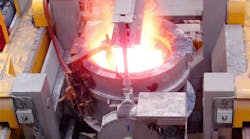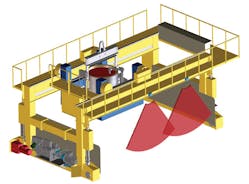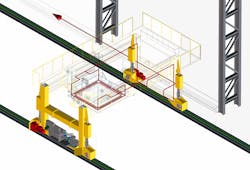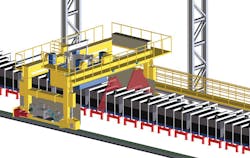The process of planning, redesigning, or updating metalcasting operations centers on three critical issues: safety, environmental compliance, and operational efficiency. As an engineering and contracting company specializing in designing and executing such projects, Gemco Engineers recognizes how important it is to address each of these details early in the design phase. As engineers and designers, the goal is to conceive the entire foundry process, including the equipment, installation, utilities, and the building as one that is as efficient as it possible can be, taking into account optimal selection of equipment, and the most effective interaction of each system, and fine-tuning according to the following criteria:
- selected casting process for the product;
- the selection and arrangements of equipment, utilities, and the building; and
- production planning, work processes, timelines and maintenance, and safety.
Gemco employs a foundry logistics simulation tool in order to identify probable bottlenecks in a new or existing foundry concept as early as possible. In brief, a simulation model combines individual model components with its specific dynamic characteristics that correspond to the individual behavior of the equipment as used in the foundry (concept.) Each installation in the simulation model processes one or more “inputs” (e.g., sand or molten metal) to one or more “outputs” (e.g., sand molds or castings.) The outcome of the simulation makes it possible to monitor not only the possible performance of each department but also the overall performance of cooperating installations/equipment.
However, and maybe even more important, simulation also allows identifying (possible) bottlenecks, subsequently determining where improvements are required. Very often the importance of a good layout for the efficiency of a foundry is underestimated. Workers’ safety, easy and safe maintenance access, as well as a healthy working environment are imperatives and also must be taken into account as early as possible.
When optimizing a foundry to these criteria, whether in a new plant or in a foundry modernization project, it may be that the necessary installation/system cannot be found in “off the shelf” product solutions. Innovative, customized solutions must be (and frequently are) developed.
Quick, Safe Pouring
Gemco designed the semi-automated pouring system (patent pending) for bottom-pour ladles to optimize both safety and continuity on the molding line. Pouring is operated via remote control from a walkway beside the pouring/molding lines. The system transports liquid metal from the melting area to the pouring area and subsequently moves over the molding line to pour the molten metal in the molds. The pouring ladle is mounted on a rigid support structure/frame outfitted with load cells to display the pouring weight.
The pouring machine is equipped with a pouring position finder (PPF, see Fig.1) that scans the molds with lasers to register the pouring cups and mold heights in order to determine the exact pouring position at a minimum height between the ladle’s bottom pour nozzle and top of the molds. Scanning is possible when a) the molds carry pouring cups of a data-based predefined geometry, or b) the pouring cups are set up with identifiable marks. After scanning the molds, the pouring cup positions are stored in the control system’s memory.
Next, it automatically moves to its starting pouring position to fill the molds safely and apace with the required molten metal and automatically moves on to the next mold. The displayed weight indicates the pouring weight per mold and shows when the ladle is almost empty and has to return to the pig out in order to receive a new ladle.
The (currently operating) pouring system can be designed for ladles from 6 to 40 metric tons of molten metal. To allow the system to operate with different mold heights and pouring cup positions, the pouring height can be hydraulically adjusted, depending on molding operations’ requirements. The positioning system is automated, though manually operated positioning is possible. The system allows movement in three directions.
Furthermore, the system carries an integrated fume extraction device built in to the ladle-supporting structure, enabling fumes to be evacuated immediately during and after pouring to minimize fume-levels in the working environment. The extracted dust and fume are transported through a closed system connected directly to the main extraction system. (See Fig. 2)
The pouring system operates faster than an overhead crane and as a result reduces the loss of temperature of the molten metal. Controlled continuous/consistent speed, accurate positioning simultaneously pouring at a minimum distance between nozzle and pouring cup reduces the overall pouring time, reduces spillage, improves the casting process and provides for safe transport of liquid steel. The configuration of the pouring system enables easy and safe access for maintenance or troubleshooting which ultimately translates in increased efficiency. The pouring machine drives on rails and has walkways/platforms on both sides of the bridge allowing access to the platform on the ladle trolley.
The automated pouring system significantly improves overall safety conditions around the pouring operations. Also, pouring operations that involve bottom-pour ladles using an overhead crane usually require two or more operators to perform the practice; Gemco’s pouring system require just one operator.
Considerations, Advantages of PPF
Among the developments that foundry operators will recognize with the adoption of the automated pouring machine are significantly improved safety conditions: operators are isolated from machine and molten metal hazards thanks to remote controls and separate, dedicated working platforms.
Safety interlocks ensure that operators and maintenance personnel are not injured by unexpected or uncontrolled movements of the machine.
Workplace ergonomics are improved too, thanks to easy-to-access platforms, remote control devices, and remote panels. The operating system is easy to access too, for routine maintenance or troubleshooting.
Also, the integrated dust/smoke extraction capability during the pouring process minimizes the harmful effect of emissions in the workplace environment.
Among the measurable advantages of the automated pouring machine, foundries will recognize a reduction of time from tapping to pouring, and between pouring sequences. Also, there will be a reduction in temperature loss to the molten metal, which will improve the quality of the casting process.
The minimized pouring height that is achieved by the system will aid the effort to retain material properties. With precision positioning of the nozzle over the pouring cup, there is less metal lost to spillage.
Finally, the foundry will achieve labor cost savings by reducing the number of operators need to execute the pouring process.
Gemco also offers a pouring system for smaller ladle capacities, with PPF technology for suspended pouring using an overhead crane. This system can replace or be added to an existing overhead pouring crane in any flexible floor molding layout.
Bas van Gemert is the managing director, and Huub van der Weiden is the sales manager, and both are affiliated with Gemco Engineers B.V., Eindhoven, The Netherlands.












